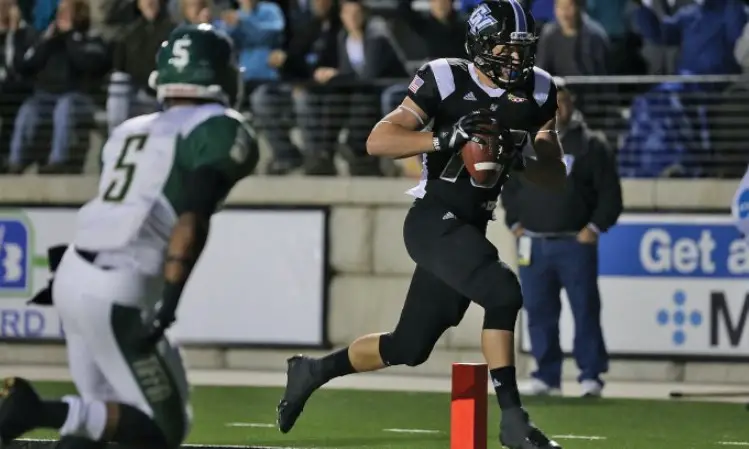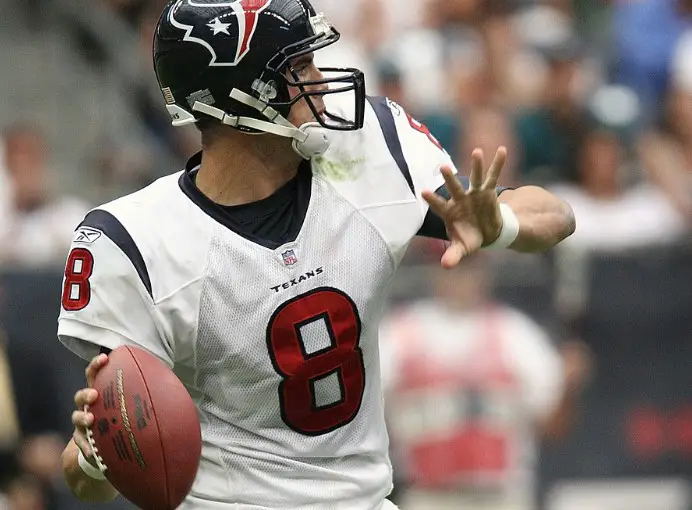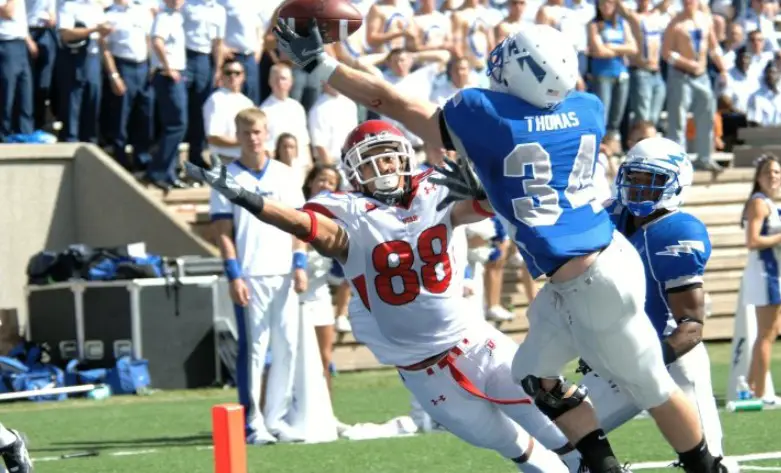Last Updated on October 2, 2023 by Alex PT
A Wide Receiver in football is typically a faster, agile player who primarily catches passes. A Tight End, on the other hand, is a larger, versatile player who blocks and catches passes. Wide receivers often line up wide, while tight ends line up closer to the offensive line.
Who is a Wide Receiver in American Football?

A wide receiver is a member of the offensive team in American football, usually stationed on the far side of the field from the Quarterback. He is responsible for catching passes thrown by the Quarterback and then running with the ball to advance it downfield.
It’s his job to catch anything the Quarterback throws his way, but he can also take out defenders on any pass route. As one of the critical positions in any offense, he needs to have excellent hands and awareness to maximize his Yardage After Catches (YAC).
Who Is a Tight End?

A tight end is a player whose position is on the offense. The tight end is considered a hybrid position with the characteristics and roles of both an offensive lineman and a wide receiver. Like offensive linemen, they are usually larger than wide receivers and are better at blocking.
Like wide receivers, they are eligible to catch passes and line up split outside the offensive line. Their duties include pass catching, defending against the run or pass, and blocking. Some tight ends are bigger and stronger than most other players on the field.
The Difference Between a Wide Receiver and a Tight End

A wide receiver is an offensive player in American football who lines up at the line of scrimmage and runs pass patterns to receive passes from the Quarterback. A tight end is also an offensive player, but he lines up behind the line of scrimmage and usually stays in to block. He may also be a receiver, but his main job is blocking.
1. The Difference in Rushing Plays
In general, wide receivers will be the better choice for rushing plays. This is because they have more speed and agility, which is needed to get around defenders. Additionally, they are typically better at catching the ball, an essential skill for running backs. However, tight ends can be a good option if you need someone more physical and can block well. This is because they are usually bigger and stronger than wide receivers.
2. The Difference in Passing Plays
Another notable difference between a wide receiver and a tight end is passing plays. In most passing plays, the wide receiver will run a specific route designed to get open for a pass. On the other hand, the tight end is usually responsible for blocking defenders to give the quarterback time to throw or open up space for the running back. When not blocking, the tight end may help with short-yardage situations by catching a quick pass near the line of scrimmage before running it downfield.
3. The Difference in Body Build
Their body build is a notable difference between a wide receiver and a tight-end football player. A wide receiver is typically lean and muscular, with long arms to help them catch the ball. On the other hand, a tight end is bigger and stronger, with short arms.
This difference in body build is due to the players’ different roles on the field. Receivers are often lined up close to the line of scrimmage and are usually not as big or strong as tight ends. They need speed and agility on defense to run downfield after the Quarterback. On offense, they need agility to run precise routes around defenders, trying to prevent them from catching the ball.
A tight end will be blocking for another player (or running routes) while a receiver is catching passes thrown by an offensive player on that team.
Skills Sets of a Wide Receiver
A wide receiver is responsible for running pass routes and catching passes. They must have good hand-eye coordination, be able to run precise routes and have the speed to outrun defenders. A receiver’s main job is to create separation between themselves and the defender.
Speed
In general, wide receivers are faster than tight ends. This is because they need to be able to run routes quickly and get open for passes. While tight ends also need to be fast, they don’t necessarily need to be as fast as wide receivers.
Good Hands
To be a good receiver, you need to have good hands. This means you can catch the ball even if it is thrown slightly off target. You also need to be able to adjust your body to make catches in traffic.
When running with the ball, receivers need to be elusive so that defenders cannot efficiently tackle them.
Good Running Skills
Receivers also need good running skills because they often run with the ball during plays. They are usually fast enough runners to avoid being tackled by defensive players when this happens.
Ability to Run Routes
A wide receiver’s primary job is to run routes and get open for a pass. They typically line up outside the formation, giving them a better chance of running untouched into open space. A tight end’s primary job is to block, but they are also often used as receivers. They usually line up on the inside of the formation, which gives them a better chance of being in a position to make a block.
The Skill Sets of a Tight End
Size
A tight end is usually one of the taller players on the team, with an average height of around 6’4. They also tend to be heavier than wide receivers, averaging about 250 pounds. This extra size and weight make them better blockers than wide receivers, which is one of their primary responsibilities. They also need to be able to catch passes, but their primary role is as a blocker.
Body Control Skills
To be an effective tight end, you must have excellent body control skills. This means being able to contort your body to make catches in challenging situations, as well as being able to shield defenders from the ball. You also need to be able to block effectively, which requires good hand-eye coordination and anticipating your opponent’s subsequent actions.
Other Skills of a Tight End
While tight ends are not used as much as wide receivers in the passing game, they still need good hands. They also need to be able to block well since they will often be asked to stay in and block instead of going out for a pass. Some tight ends are used as H-backs. They line up in the backfield and act as lead blockers or receivers out of the backfield.
Wide Receiver Roles and Responsibilities
Wide receivers in American football play crucial roles in the offense, primarily focused on receiving passes from the quarterback. Their roles and responsibilities include:
- Route Running: Wide receivers run precise routes designed to create separation from defenders. These routes can vary from short, quick patterns to deep routes down the field.
- Catching Passes: Their primary duty is to catch passes thrown by the quarterback. This requires excellent hand-eye coordination, concentration, and strong hands to secure the football, especially in contested catches.
- Yards After Catch (YAC): Wide receivers aim to gain additional yards after catching the ball. They use their speed, agility, and vision to elude defenders and extend plays.
- Blocking: While not as common as in running backs or tight ends, wide receivers are occasionally called upon to block for running plays or screen passes. Effective blocking can spring a ball carrier for significant gains.
- Reading Defenses: Wide receivers must read the defensive coverage to adjust their routes and find open spaces. This requires football IQ and the ability to make quick decisions on the field.
- Red Zone Targets: In the red zone (inside the opponent’s 20-yard line), wide receivers are targeted for touchdown passes. They use their route-running skills and body positioning to create opportunities for scoring.
- Ball Security: Protecting the football is vital. Wide receivers must secure the ball to prevent fumbles, as turnovers can be costly.
- Special Teams: Some wide receivers contribute on special teams units as kick or punt returners. Their agility and speed make them valuable in open-field situations.
- Blocking Downfield: On running plays or screen passes, wide receivers may be asked to block downfield to clear the path for ball carriers.
- Communication: Wide receivers communicate with the quarterback, often through hand signals or non-verbal cues, to adjust routes based on defensive reads.
- Route Tree: They must master a variety of routes, including curls, slants, fades, posts, and go routes, to keep defenses guessing.
- Versatility: Some wide receivers possess versatility, lining up in different positions (e.g., slot receiver, outside receiver) to exploit matchups and create offensive advantages.
- Understanding Defensive Coverages: Wide receivers need to recognize various defensive coverages (man-to-man, zone, press coverage) and adjust their routes accordingly.
- Physicality: While not as physically involved as blockers, wide receivers need to use their physicality to shed defenders when running routes and making catches.
- Endurance: Wide receivers often run long distances during a game, requiring endurance to maintain their speed and effectiveness.
Tight End Roles and Responsibilities
Tight Ends in American football play versatile roles, combining elements of both offensive linemen and receivers. Their roles and responsibilities include:
- Blocking: Tight ends are essential in both running and passing plays. They block defensive players to create running lanes for the ball carrier and protect the quarterback during pass plays.
- Receiving: Tight ends are eligible receivers and catch passes from the quarterback. They often serve as intermediate targets over the middle of the field, creating mismatches with their size and athleticism against linebackers and safeties.
- Route Running: Tight ends run a variety of routes, including short, intermediate, and occasionally deep routes. They must be precise in their route running and have good hands to make catches in traffic.
- Red Zone Target: Due to their size advantage, tight ends are frequently targeted in the red zone (the area inside the opponent’s 20-yard line). They use their height and physicality to make touchdown catches.
- Run After Catch: Tight ends are expected to gain yards after catching the ball, breaking tackles, and maximizing yardage gained.
- Versatility: Modern tight ends are increasingly versatile, often lining up in different positions (e.g., inline, slot, or split wide) to create mismatches with defenders. This flexibility adds complexity to the offense.
- Blocking Techniques: Tight ends use various blocking techniques, including drive blocking (moving defenders backward), zone blocking (maintaining a position to create a running lane), and pass protection (blocking pass rushers to protect the quarterback).
- Knowledge of Offensive Schemes: Tight ends must understand complex offensive schemes, including blocking assignments, route adjustments, and pass protection responsibilities.
- Special Teams: Some tight ends contribute on special teams units, participating in kick coverage or return teams.
- Communication: Tight ends communicate with the quarterback and offensive line, making pre-snap adjustments based on the defensive alignment.
- Athleticism and Physicality: They need a combination of athleticism to make plays in the passing game and physicality to excel in blocking situations.
- Blocking in Space: In addition to blocking at the line of scrimmage, tight ends often block in space, engaging defenders downfield to create opportunities for ball carriers.
Frequently Asked Questions About the Difference Between a Wide Receiver and a Tight End
Do Tight Ends Have to Be Big and Strong?
Besides the height, tight ends need to be strong and big-bodied enough to take the tackling they will when blocking. Tight ends are mostly asked to block some strong and more athletic defenders on the field.
Who Guards a Tight End?
A linebacker usually guards a tight end during a route pass playstyle. However, there are situations where the defense will turn a linebacker out for safety to guard the tight end on a pass play. Some teams usually elect two defenders to block a tight end during a pass playstyle.
Conclusion
The wide receiver (WR) is the pass-catching specialist in American football. Their primary job is to run pass routes and catch passes. A tight end (TE) is a hybrid player who can do a little bit of everything—they can block, catch passes, and run routes. The difference between a wide receiver and a tight end comes down to their size, speed, and role in the offense.
Reference 1: Wide Receiver Vs Tight End What Is The Difference? – Four Verts Football
Reference 2: What Does A Tight End Do In Football? (rookieroad.com)

Hi! I’m Alex PT. I hold a Bachelor’s degree in Sports Management from Indiana University and have over seven years of valuable experience working in a Sports Event Management Company. I founded SportBlurb with the passion for bringing you the latest, most insightful, and engaging content in the world of sports. So, whether you’re a die-hard fan or want to stay informed, I’ve got you covered!

